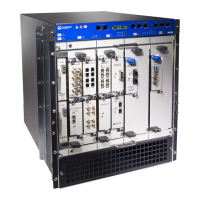CHAPTER 32
Troubleshooting Components
•
Overview of Troubleshooting Resources for the M120 Router on page 283
•
M120 LED Overview on page 284
•
Troubleshooting the M120 Cooling System on page 286
•
Troubleshooting M120 FPCs and CFPCs on page 287
•
Troubleshooting M120 PICs on page 288
•
Troubleshooting the M120 Power System on page 288
•
Troubleshooting M120 FEBs on page 289
•
Troubleshooting an M120 FEB When a Chassis Alarm Is Lit Upon Initial Startup or
Removal on page 291
Overview of Troubleshooting Resources for the M120 Router
•
Troubleshooting Using the Command-Line Interface on page 283
•
Troubleshooting Using the Chassis and Interface Alarm Messages on page 284
•
Troubleshooting Using the Juniper Networks Technical Assistance Center on page 284
Troubleshooting Using the Command-Line Interface
The Junos OS command-line interface (CLI) is the primary tool for controlling and
troubleshooting router hardware, the Junos OS, routing protocols, and network
connectivity. CLI commands display information from routing tables, information specific
to routing protocols, and information about network connectivity derived from the ping
and traceroute utilities.
You enter CLI commands on one or more external management devices connected to
the Routing Engine through ports on the Craft Interface. The port labeled AUX attaches
the Routing Engine to a laptop, modem, or other auxiliary device, the port labeled
CONSOLE attaches to a system console, and the port labeled ETHERNET attaches to a
management LAN. For more information, see “M120 Routing Engine Description” on
page 22.
For information about using the CLI to display details about alarms generated by interfaces
and hardware components, see “Troubleshooting Using the Chassis and Interface Alarm
Messages” on page 284.
283Copyright © 2018, Juniper Networks, Inc.

